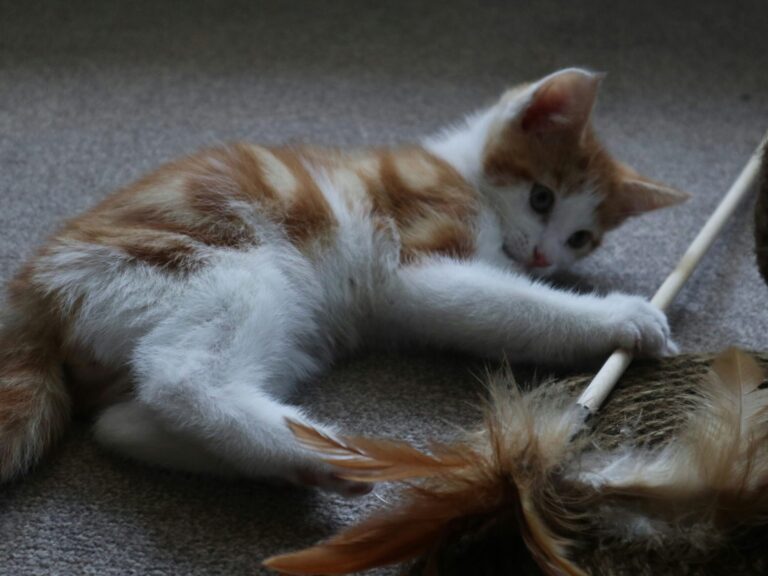I. Make Your Cat Work For His Food:
- This can be very stimulating for cats and help reduce stress. Instead of just putting dry food in a bowl you can put the food inside a toy that allows your cat to think, play, and move. Here are some ideas:
- Treat balls: These toys can be ordered online by searching for “cat treat balls.” Treats or dry food are placed in these toys and the cat learns to move the toy to dispense the treats. It’s very stimulating for cats.
- Homemade treat balls:
Take an empty paper towel or toilet paper roll and seal the ends with tape. Make some holes in the tube that are large enough for kibble and treats to fall out. Place cat treats or dry food in the tube. Show your cat that when she rolls the tube treats or food falls out of it for her to eat!
- Place dry food or treats in an empty cardboard egg carton and watch your cat enjoy pawing the food out of the carton.
- Foraging: Place small amounts of dry or canned food on small plates throughout the home for your cat to find.
- Fetch: Play fetch with your cat during feeding time by throwing dry food, one kibble at a time, down a hallway for your cat to chase and eat.
II. Interactive Toys:
Cats like to chase and catch things. Three interactive toys are:
- Fishing Rod Toys – These are the best type of cat toys. They feature a rod and a three foot string that has feathers attached to the end. They are available at any pet store or you can make them using materials you have at home.
- Laser Lights – Some cats also like a cat laser light.
- Cat Charmer Cat Dancer – only $2 on Amazon.com
III. Scratching Post:
Most cats like to have a designated place to scratch. Scratching posts can be ordered online or found at pet supply retailers. The best scratching posts are at least 30” high, sturdy, and made of a type of rope called sisal. A low cost alternative is to bring sturdy cardboard into the home for the cat to scratch.
IV. High Resting Spaces:
Cat trees allow the cat to look out the window at birds or other animals and this engages their attention. High resting spaces are also essential as it increases the space in your home and allows cats to work out territorial issues without any overt or covert aggression. High resting spaces can be anywhere from one foot to eight feet high and can include furniture, shelving, cabinet space, desk space or any other sturdy object to which a cat can have safe access.
V. New Paper Bags and Cardboard Boxes:
Introduce new paper bags and cardboard boxes into the home weekly. Cats love to explore and play with these items. Many grocery stores will give out boxes that they were going to recycle.
VI. Ping Pong Ball:
Put in the bathtub for the cat to bat around. Or put a ping pong ball in an empty tissue box.
VII. Catnip:
Most adult cats love catnip. You can purchase a bag of it inexpensively. (Make sure it’s only composed of leaves and blossoms, and not stems.) You can rub it on toys or on the scratching post; put some on the ground for cat to roll around in; place some in a sock and tie a knot around one end. Only use it two to three times a week, as with too much exposure cats can develop a tolerance to catnip and it loses its effect.
VIII. Tin Foil Balls:
Make a ball out of tin foil (about the size of a ping pong ball) and the cat will play soccer with it. (Note: some cats will try to eat the foil which is not good for them, so if you see your cat doing this don’t use these balls.)
IX. DVD for Your Cat to Watch:
Some cats really enjoy watching DVDs designed for felines and it’s a great way to occupy them. You can find these online by searching terms such as “cat DVDs” or “DVDs for cats”.
X. Interactive Games (Without You):
Some toys are designed to keep your cat engaged even when you cannot be there. Many of these are available online by searching for “cat solo toys.” Many are wooden and have holes in it so the cat can bat at the objects you place inside the toy. Once you see the design online you can also choose to make your own similar toy with a little creativity and a cardboard box.

